Clinical Therapeutics: Comprehensive Case Study of Mr. DM's Management
VerifiedAdded on 2023/06/06
|8
|2656
|352
Case Study
AI Summary
This case study focuses on the clinical management of Mr. DM, a patient diagnosed with Diabetes Type 2 (DM2), Chronic Kidney Damage (CKD), Chronic Obstructive Pulmonary Disease (COPD), Gout, Mild Osteoarthritis (OA), and total hyperopia. The analysis includes identification and discussion of standard guideline recommendations for each condition, emphasizing lifestyle changes, medication management, and therapeutic interventions. The study highlights the importance of considering drug-drug interactions, co-morbidities, and potential risks associated with various treatment options. Management recommendations involve tailored approaches for each condition, such as low-dose allopurinol for gout, lifestyle adjustments for COPD, and careful cardiovascular risk management for CKD. The clinical decisions are justified based on evidence-based interventions, patient self-management education, and a comprehensive understanding of the patient's complex medical history, aiming to improve overall health outcomes and quality of life. Desklib provides similar case studies and solved assignments for students.
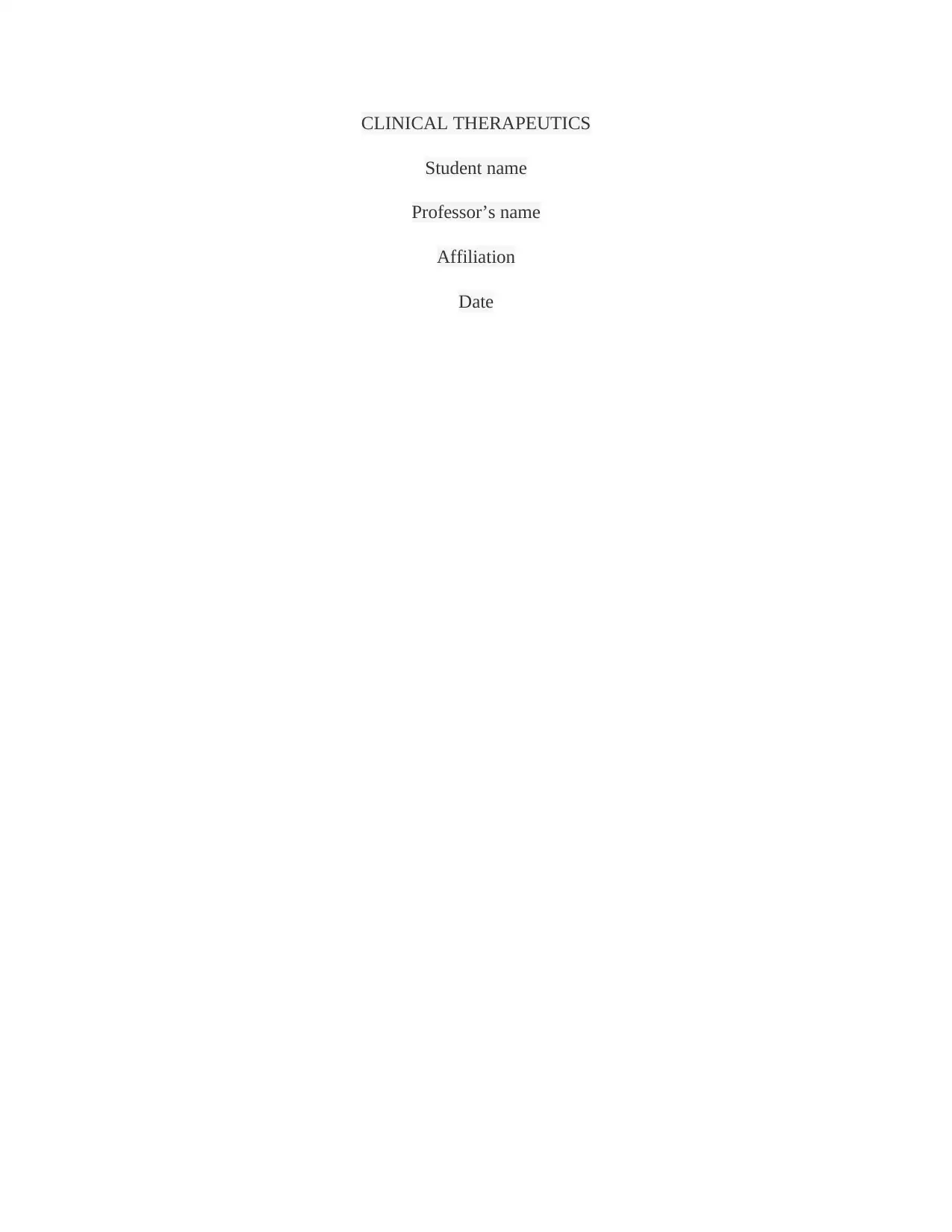
CLINICAL THERAPEUTICS
Student name
Professor’s name
Affiliation
Date
Student name
Professor’s name
Affiliation
Date
Paraphrase This Document
Need a fresh take? Get an instant paraphrase of this document with our AI Paraphraser
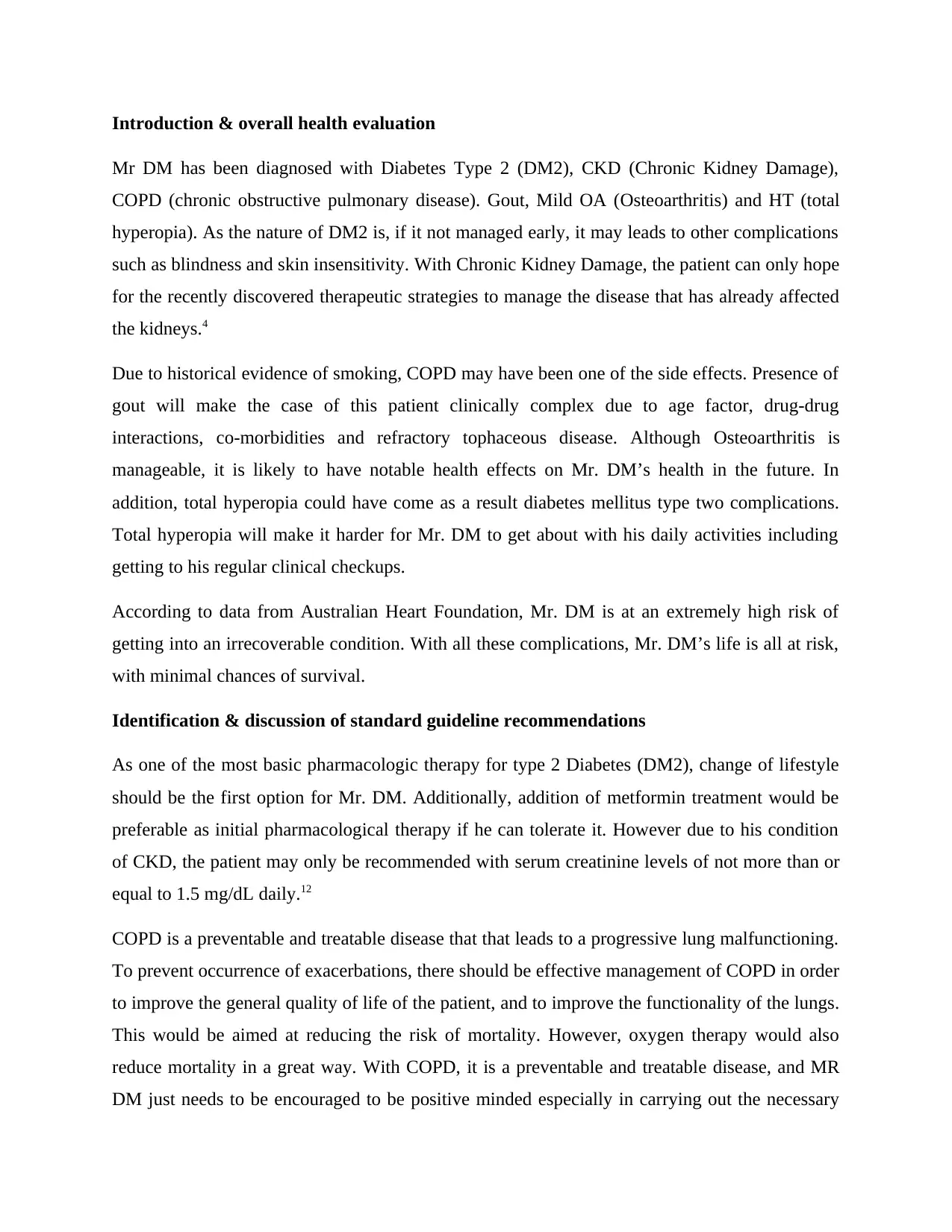
Introduction & overall health evaluation
Mr DM has been diagnosed with Diabetes Type 2 (DM2), CKD (Chronic Kidney Damage),
COPD (chronic obstructive pulmonary disease). Gout, Mild OA (Osteoarthritis) and HT (total
hyperopia). As the nature of DM2 is, if it not managed early, it may leads to other complications
such as blindness and skin insensitivity. With Chronic Kidney Damage, the patient can only hope
for the recently discovered therapeutic strategies to manage the disease that has already affected
the kidneys.4
Due to historical evidence of smoking, COPD may have been one of the side effects. Presence of
gout will make the case of this patient clinically complex due to age factor, drug-drug
interactions, co-morbidities and refractory tophaceous disease. Although Osteoarthritis is
manageable, it is likely to have notable health effects on Mr. DM’s health in the future. In
addition, total hyperopia could have come as a result diabetes mellitus type two complications.
Total hyperopia will make it harder for Mr. DM to get about with his daily activities including
getting to his regular clinical checkups.
According to data from Australian Heart Foundation, Mr. DM is at an extremely high risk of
getting into an irrecoverable condition. With all these complications, Mr. DM’s life is all at risk,
with minimal chances of survival.
Identification & discussion of standard guideline recommendations
As one of the most basic pharmacologic therapy for type 2 Diabetes (DM2), change of lifestyle
should be the first option for Mr. DM. Additionally, addition of metformin treatment would be
preferable as initial pharmacological therapy if he can tolerate it. However due to his condition
of CKD, the patient may only be recommended with serum creatinine levels of not more than or
equal to 1.5 mg/dL daily.12
COPD is a preventable and treatable disease that that leads to a progressive lung malfunctioning.
To prevent occurrence of exacerbations, there should be effective management of COPD in order
to improve the general quality of life of the patient, and to improve the functionality of the lungs.
This would be aimed at reducing the risk of mortality. However, oxygen therapy would also
reduce mortality in a great way. With COPD, it is a preventable and treatable disease, and MR
DM just needs to be encouraged to be positive minded especially in carrying out the necessary
Mr DM has been diagnosed with Diabetes Type 2 (DM2), CKD (Chronic Kidney Damage),
COPD (chronic obstructive pulmonary disease). Gout, Mild OA (Osteoarthritis) and HT (total
hyperopia). As the nature of DM2 is, if it not managed early, it may leads to other complications
such as blindness and skin insensitivity. With Chronic Kidney Damage, the patient can only hope
for the recently discovered therapeutic strategies to manage the disease that has already affected
the kidneys.4
Due to historical evidence of smoking, COPD may have been one of the side effects. Presence of
gout will make the case of this patient clinically complex due to age factor, drug-drug
interactions, co-morbidities and refractory tophaceous disease. Although Osteoarthritis is
manageable, it is likely to have notable health effects on Mr. DM’s health in the future. In
addition, total hyperopia could have come as a result diabetes mellitus type two complications.
Total hyperopia will make it harder for Mr. DM to get about with his daily activities including
getting to his regular clinical checkups.
According to data from Australian Heart Foundation, Mr. DM is at an extremely high risk of
getting into an irrecoverable condition. With all these complications, Mr. DM’s life is all at risk,
with minimal chances of survival.
Identification & discussion of standard guideline recommendations
As one of the most basic pharmacologic therapy for type 2 Diabetes (DM2), change of lifestyle
should be the first option for Mr. DM. Additionally, addition of metformin treatment would be
preferable as initial pharmacological therapy if he can tolerate it. However due to his condition
of CKD, the patient may only be recommended with serum creatinine levels of not more than or
equal to 1.5 mg/dL daily.12
COPD is a preventable and treatable disease that that leads to a progressive lung malfunctioning.
To prevent occurrence of exacerbations, there should be effective management of COPD in order
to improve the general quality of life of the patient, and to improve the functionality of the lungs.
This would be aimed at reducing the risk of mortality. However, oxygen therapy would also
reduce mortality in a great way. With COPD, it is a preventable and treatable disease, and MR
DM just needs to be encouraged to be positive minded especially in carrying out the necessary
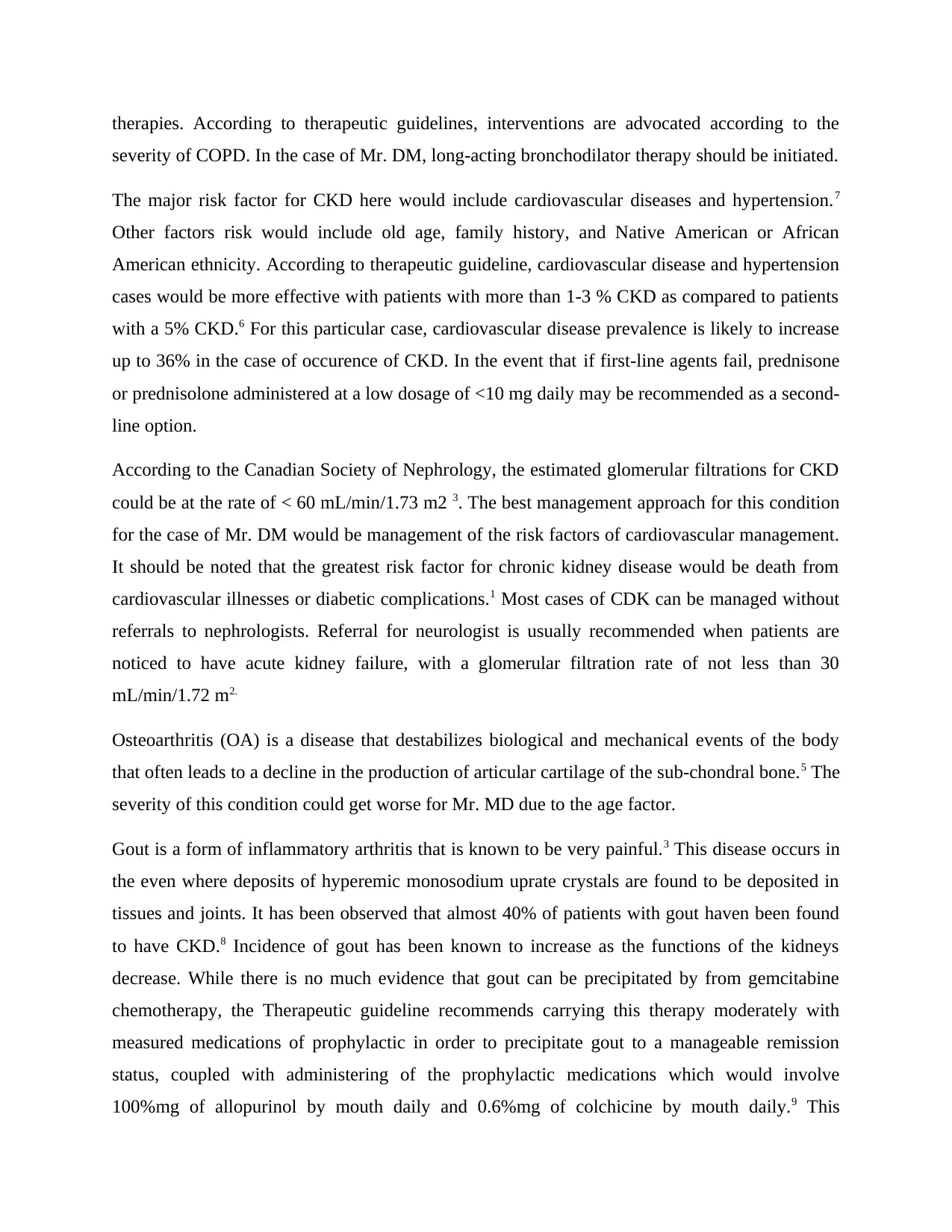
therapies. According to therapeutic guidelines, interventions are advocated according to the
severity of COPD. In the case of Mr. DM, long-acting bronchodilator therapy should be initiated.
The major risk factor for CKD here would include cardiovascular diseases and hypertension.7
Other factors risk would include old age, family history, and Native American or African
American ethnicity. According to therapeutic guideline, cardiovascular disease and hypertension
cases would be more effective with patients with more than 1-3 % CKD as compared to patients
with a 5% CKD.6 For this particular case, cardiovascular disease prevalence is likely to increase
up to 36% in the case of occurence of CKD. In the event that if first-line agents fail, prednisone
or prednisolone administered at a low dosage of <10 mg daily may be recommended as a second-
line option.
According to the Canadian Society of Nephrology, the estimated glomerular filtrations for CKD
could be at the rate of < 60 mL/min/1.73 m2 3. The best management approach for this condition
for the case of Mr. DM would be management of the risk factors of cardiovascular management.
It should be noted that the greatest risk factor for chronic kidney disease would be death from
cardiovascular illnesses or diabetic complications.1 Most cases of CDK can be managed without
referrals to nephrologists. Referral for neurologist is usually recommended when patients are
noticed to have acute kidney failure, with a glomerular filtration rate of not less than 30
mL/min/1.72 m2.
Osteoarthritis (OA) is a disease that destabilizes biological and mechanical events of the body
that often leads to a decline in the production of articular cartilage of the sub-chondral bone.5 The
severity of this condition could get worse for Mr. MD due to the age factor.
Gout is a form of inflammatory arthritis that is known to be very painful.3 This disease occurs in
the even where deposits of hyperemic monosodium uprate crystals are found to be deposited in
tissues and joints. It has been observed that almost 40% of patients with gout haven been found
to have CKD.8 Incidence of gout has been known to increase as the functions of the kidneys
decrease. While there is no much evidence that gout can be precipitated by from gemcitabine
chemotherapy, the Therapeutic guideline recommends carrying this therapy moderately with
measured medications of prophylactic in order to precipitate gout to a manageable remission
status, coupled with administering of the prophylactic medications which would involve
100%mg of allopurinol by mouth daily and 0.6%mg of colchicine by mouth daily.9 This
severity of COPD. In the case of Mr. DM, long-acting bronchodilator therapy should be initiated.
The major risk factor for CKD here would include cardiovascular diseases and hypertension.7
Other factors risk would include old age, family history, and Native American or African
American ethnicity. According to therapeutic guideline, cardiovascular disease and hypertension
cases would be more effective with patients with more than 1-3 % CKD as compared to patients
with a 5% CKD.6 For this particular case, cardiovascular disease prevalence is likely to increase
up to 36% in the case of occurence of CKD. In the event that if first-line agents fail, prednisone
or prednisolone administered at a low dosage of <10 mg daily may be recommended as a second-
line option.
According to the Canadian Society of Nephrology, the estimated glomerular filtrations for CKD
could be at the rate of < 60 mL/min/1.73 m2 3. The best management approach for this condition
for the case of Mr. DM would be management of the risk factors of cardiovascular management.
It should be noted that the greatest risk factor for chronic kidney disease would be death from
cardiovascular illnesses or diabetic complications.1 Most cases of CDK can be managed without
referrals to nephrologists. Referral for neurologist is usually recommended when patients are
noticed to have acute kidney failure, with a glomerular filtration rate of not less than 30
mL/min/1.72 m2.
Osteoarthritis (OA) is a disease that destabilizes biological and mechanical events of the body
that often leads to a decline in the production of articular cartilage of the sub-chondral bone.5 The
severity of this condition could get worse for Mr. MD due to the age factor.
Gout is a form of inflammatory arthritis that is known to be very painful.3 This disease occurs in
the even where deposits of hyperemic monosodium uprate crystals are found to be deposited in
tissues and joints. It has been observed that almost 40% of patients with gout haven been found
to have CKD.8 Incidence of gout has been known to increase as the functions of the kidneys
decrease. While there is no much evidence that gout can be precipitated by from gemcitabine
chemotherapy, the Therapeutic guideline recommends carrying this therapy moderately with
measured medications of prophylactic in order to precipitate gout to a manageable remission
status, coupled with administering of the prophylactic medications which would involve
100%mg of allopurinol by mouth daily and 0.6%mg of colchicine by mouth daily.9 This
⊘ This is a preview!⊘
Do you want full access?
Subscribe today to unlock all pages.

Trusted by 1+ million students worldwide
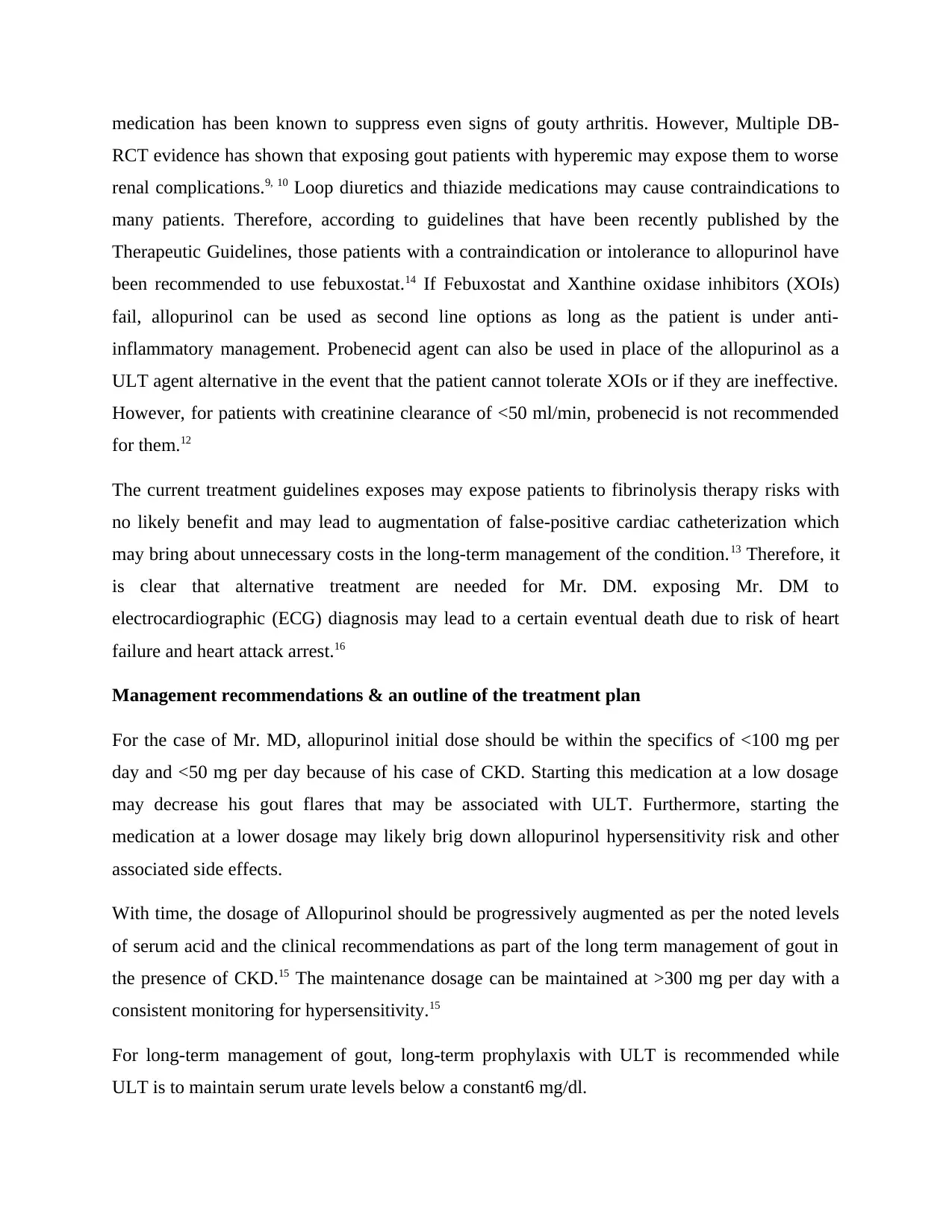
medication has been known to suppress even signs of gouty arthritis. However, Multiple DB-
RCT evidence has shown that exposing gout patients with hyperemic may expose them to worse
renal complications.9, 10 Loop diuretics and thiazide medications may cause contraindications to
many patients. Therefore, according to guidelines that have been recently published by the
Therapeutic Guidelines, those patients with a contraindication or intolerance to allopurinol have
been recommended to use febuxostat.14 If Febuxostat and Xanthine oxidase inhibitors (XOIs)
fail, allopurinol can be used as second line options as long as the patient is under anti-
inflammatory management. Probenecid agent can also be used in place of the allopurinol as a
ULT agent alternative in the event that the patient cannot tolerate XOIs or if they are ineffective.
However, for patients with creatinine clearance of <50 ml/min, probenecid is not recommended
for them.12
The current treatment guidelines exposes may expose patients to fibrinolysis therapy risks with
no likely benefit and may lead to augmentation of false-positive cardiac catheterization which
may bring about unnecessary costs in the long-term management of the condition.13 Therefore, it
is clear that alternative treatment are needed for Mr. DM. exposing Mr. DM to
electrocardiographic (ECG) diagnosis may lead to a certain eventual death due to risk of heart
failure and heart attack arrest.16
Management recommendations & an outline of the treatment plan
For the case of Mr. MD, allopurinol initial dose should be within the specifics of <100 mg per
day and <50 mg per day because of his case of CKD. Starting this medication at a low dosage
may decrease his gout flares that may be associated with ULT. Furthermore, starting the
medication at a lower dosage may likely brig down allopurinol hypersensitivity risk and other
associated side effects.
With time, the dosage of Allopurinol should be progressively augmented as per the noted levels
of serum acid and the clinical recommendations as part of the long term management of gout in
the presence of CKD.15 The maintenance dosage can be maintained at >300 mg per day with a
consistent monitoring for hypersensitivity.15
For long-term management of gout, long-term prophylaxis with ULT is recommended while
ULT is to maintain serum urate levels below a constant6 mg/dl.
RCT evidence has shown that exposing gout patients with hyperemic may expose them to worse
renal complications.9, 10 Loop diuretics and thiazide medications may cause contraindications to
many patients. Therefore, according to guidelines that have been recently published by the
Therapeutic Guidelines, those patients with a contraindication or intolerance to allopurinol have
been recommended to use febuxostat.14 If Febuxostat and Xanthine oxidase inhibitors (XOIs)
fail, allopurinol can be used as second line options as long as the patient is under anti-
inflammatory management. Probenecid agent can also be used in place of the allopurinol as a
ULT agent alternative in the event that the patient cannot tolerate XOIs or if they are ineffective.
However, for patients with creatinine clearance of <50 ml/min, probenecid is not recommended
for them.12
The current treatment guidelines exposes may expose patients to fibrinolysis therapy risks with
no likely benefit and may lead to augmentation of false-positive cardiac catheterization which
may bring about unnecessary costs in the long-term management of the condition.13 Therefore, it
is clear that alternative treatment are needed for Mr. DM. exposing Mr. DM to
electrocardiographic (ECG) diagnosis may lead to a certain eventual death due to risk of heart
failure and heart attack arrest.16
Management recommendations & an outline of the treatment plan
For the case of Mr. MD, allopurinol initial dose should be within the specifics of <100 mg per
day and <50 mg per day because of his case of CKD. Starting this medication at a low dosage
may decrease his gout flares that may be associated with ULT. Furthermore, starting the
medication at a lower dosage may likely brig down allopurinol hypersensitivity risk and other
associated side effects.
With time, the dosage of Allopurinol should be progressively augmented as per the noted levels
of serum acid and the clinical recommendations as part of the long term management of gout in
the presence of CKD.15 The maintenance dosage can be maintained at >300 mg per day with a
consistent monitoring for hypersensitivity.15
For long-term management of gout, long-term prophylaxis with ULT is recommended while
ULT is to maintain serum urate levels below a constant6 mg/dl.
Paraphrase This Document
Need a fresh take? Get an instant paraphrase of this document with our AI Paraphraser
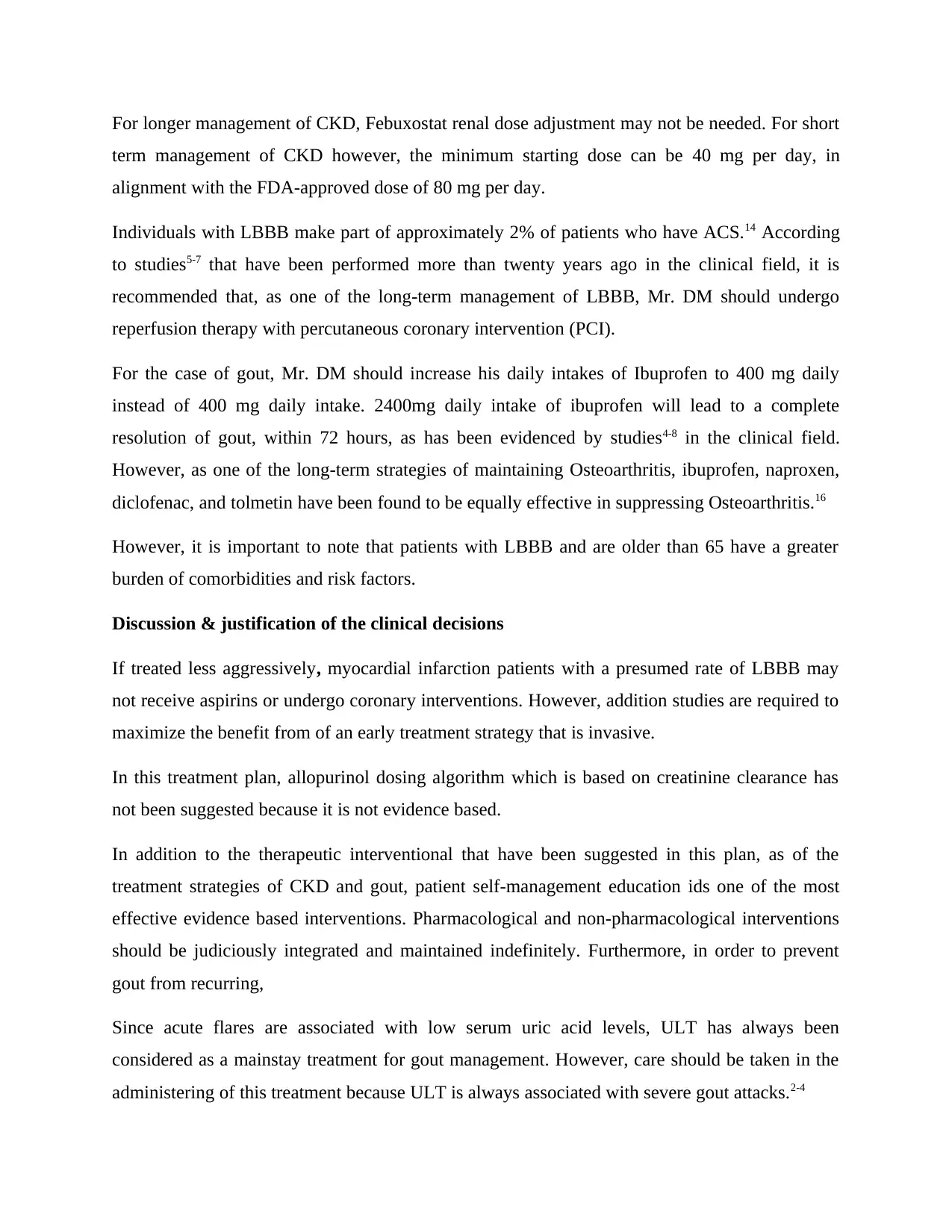
For longer management of CKD, Febuxostat renal dose adjustment may not be needed. For short
term management of CKD however, the minimum starting dose can be 40 mg per day, in
alignment with the FDA-approved dose of 80 mg per day.
Individuals with LBBB make part of approximately 2% of patients who have ACS.14 According
to studies5-7 that have been performed more than twenty years ago in the clinical field, it is
recommended that, as one of the long-term management of LBBB, Mr. DM should undergo
reperfusion therapy with percutaneous coronary intervention (PCI).
For the case of gout, Mr. DM should increase his daily intakes of Ibuprofen to 400 mg daily
instead of 400 mg daily intake. 2400mg daily intake of ibuprofen will lead to a complete
resolution of gout, within 72 hours, as has been evidenced by studies4-8 in the clinical field.
However, as one of the long-term strategies of maintaining Osteoarthritis, ibuprofen, naproxen,
diclofenac, and tolmetin have been found to be equally effective in suppressing Osteoarthritis.16
However, it is important to note that patients with LBBB and are older than 65 have a greater
burden of comorbidities and risk factors.
Discussion & justification of the clinical decisions
If treated less aggressively, myocardial infarction patients with a presumed rate of LBBB may
not receive aspirins or undergo coronary interventions. However, addition studies are required to
maximize the benefit from of an early treatment strategy that is invasive.
In this treatment plan, allopurinol dosing algorithm which is based on creatinine clearance has
not been suggested because it is not evidence based.
In addition to the therapeutic interventional that have been suggested in this plan, as of the
treatment strategies of CKD and gout, patient self-management education ids one of the most
effective evidence based interventions. Pharmacological and non-pharmacological interventions
should be judiciously integrated and maintained indefinitely. Furthermore, in order to prevent
gout from recurring,
Since acute flares are associated with low serum uric acid levels, ULT has always been
considered as a mainstay treatment for gout management. However, care should be taken in the
administering of this treatment because ULT is always associated with severe gout attacks.2-4
term management of CKD however, the minimum starting dose can be 40 mg per day, in
alignment with the FDA-approved dose of 80 mg per day.
Individuals with LBBB make part of approximately 2% of patients who have ACS.14 According
to studies5-7 that have been performed more than twenty years ago in the clinical field, it is
recommended that, as one of the long-term management of LBBB, Mr. DM should undergo
reperfusion therapy with percutaneous coronary intervention (PCI).
For the case of gout, Mr. DM should increase his daily intakes of Ibuprofen to 400 mg daily
instead of 400 mg daily intake. 2400mg daily intake of ibuprofen will lead to a complete
resolution of gout, within 72 hours, as has been evidenced by studies4-8 in the clinical field.
However, as one of the long-term strategies of maintaining Osteoarthritis, ibuprofen, naproxen,
diclofenac, and tolmetin have been found to be equally effective in suppressing Osteoarthritis.16
However, it is important to note that patients with LBBB and are older than 65 have a greater
burden of comorbidities and risk factors.
Discussion & justification of the clinical decisions
If treated less aggressively, myocardial infarction patients with a presumed rate of LBBB may
not receive aspirins or undergo coronary interventions. However, addition studies are required to
maximize the benefit from of an early treatment strategy that is invasive.
In this treatment plan, allopurinol dosing algorithm which is based on creatinine clearance has
not been suggested because it is not evidence based.
In addition to the therapeutic interventional that have been suggested in this plan, as of the
treatment strategies of CKD and gout, patient self-management education ids one of the most
effective evidence based interventions. Pharmacological and non-pharmacological interventions
should be judiciously integrated and maintained indefinitely. Furthermore, in order to prevent
gout from recurring,
Since acute flares are associated with low serum uric acid levels, ULT has always been
considered as a mainstay treatment for gout management. However, care should be taken in the
administering of this treatment because ULT is always associated with severe gout attacks.2-4
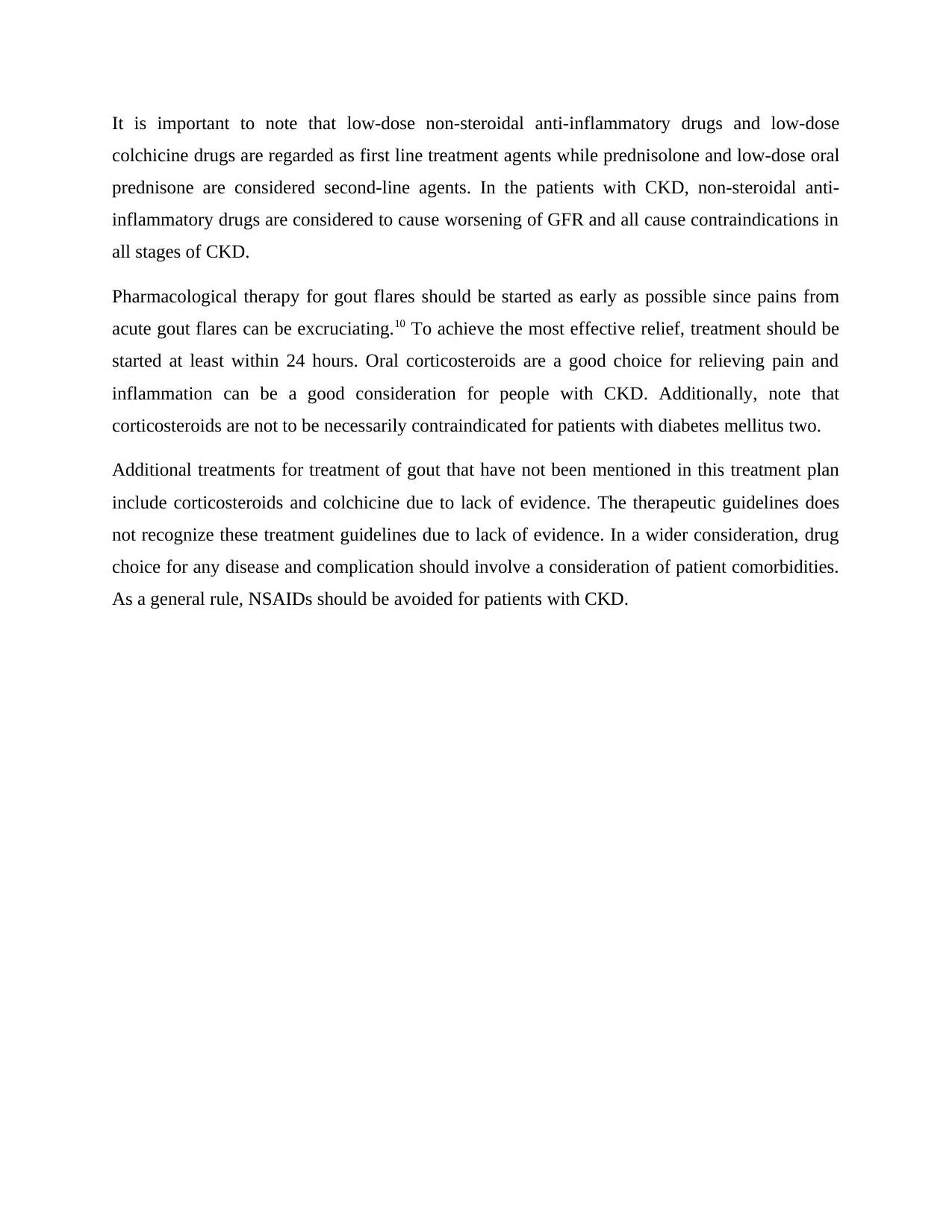
It is important to note that low-dose non-steroidal anti-inflammatory drugs and low-dose
colchicine drugs are regarded as first line treatment agents while prednisolone and low-dose oral
prednisone are considered second-line agents. In the patients with CKD, non-steroidal anti-
inflammatory drugs are considered to cause worsening of GFR and all cause contraindications in
all stages of CKD.
Pharmacological therapy for gout flares should be started as early as possible since pains from
acute gout flares can be excruciating.10 To achieve the most effective relief, treatment should be
started at least within 24 hours. Oral corticosteroids are a good choice for relieving pain and
inflammation can be a good consideration for people with CKD. Additionally, note that
corticosteroids are not to be necessarily contraindicated for patients with diabetes mellitus two.
Additional treatments for treatment of gout that have not been mentioned in this treatment plan
include corticosteroids and colchicine due to lack of evidence. The therapeutic guidelines does
not recognize these treatment guidelines due to lack of evidence. In a wider consideration, drug
choice for any disease and complication should involve a consideration of patient comorbidities.
As a general rule, NSAIDs should be avoided for patients with CKD.
colchicine drugs are regarded as first line treatment agents while prednisolone and low-dose oral
prednisone are considered second-line agents. In the patients with CKD, non-steroidal anti-
inflammatory drugs are considered to cause worsening of GFR and all cause contraindications in
all stages of CKD.
Pharmacological therapy for gout flares should be started as early as possible since pains from
acute gout flares can be excruciating.10 To achieve the most effective relief, treatment should be
started at least within 24 hours. Oral corticosteroids are a good choice for relieving pain and
inflammation can be a good consideration for people with CKD. Additionally, note that
corticosteroids are not to be necessarily contraindicated for patients with diabetes mellitus two.
Additional treatments for treatment of gout that have not been mentioned in this treatment plan
include corticosteroids and colchicine due to lack of evidence. The therapeutic guidelines does
not recognize these treatment guidelines due to lack of evidence. In a wider consideration, drug
choice for any disease and complication should involve a consideration of patient comorbidities.
As a general rule, NSAIDs should be avoided for patients with CKD.
⊘ This is a preview!⊘
Do you want full access?
Subscribe today to unlock all pages.

Trusted by 1+ million students worldwide
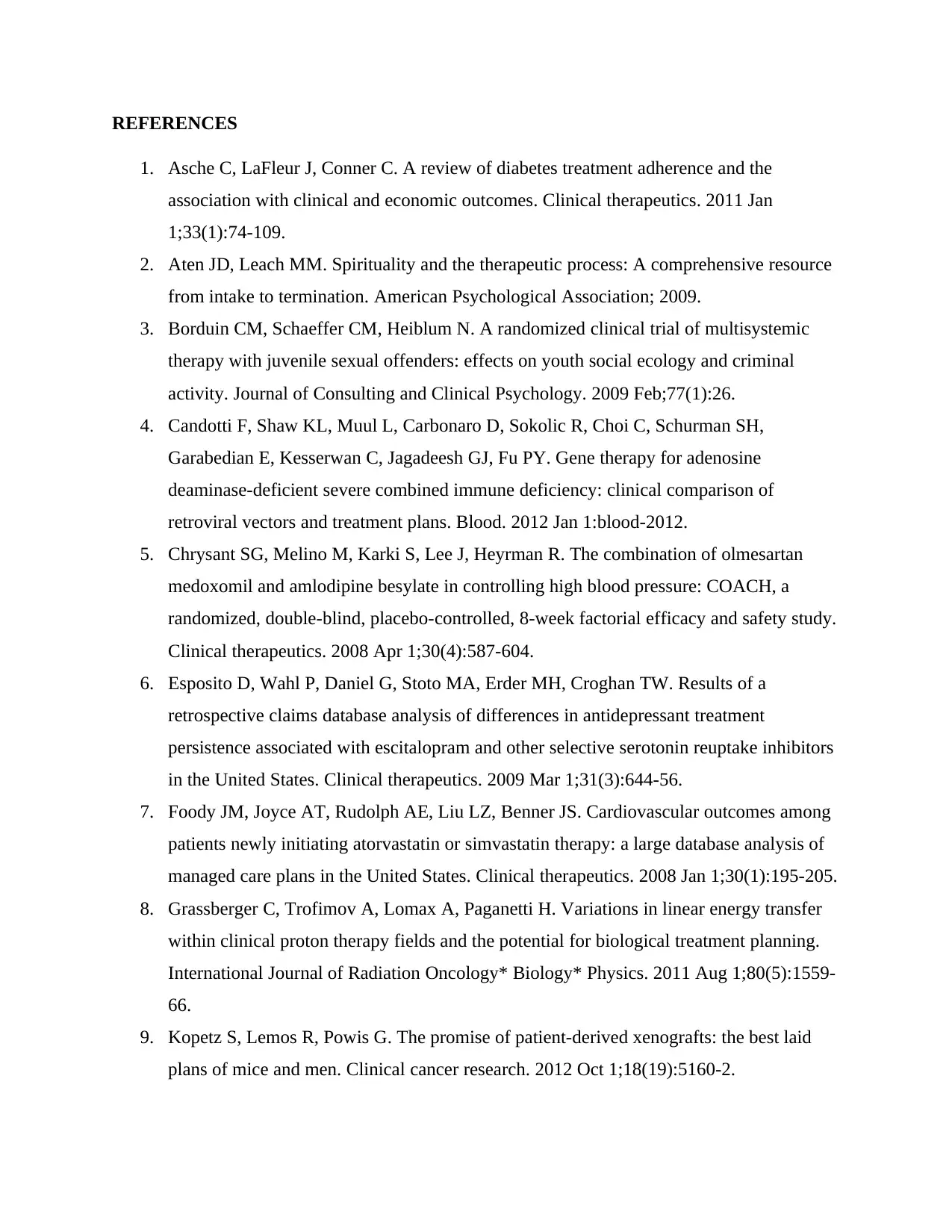
REFERENCES
1. Asche C, LaFleur J, Conner C. A review of diabetes treatment adherence and the
association with clinical and economic outcomes. Clinical therapeutics. 2011 Jan
1;33(1):74-109.
2. Aten JD, Leach MM. Spirituality and the therapeutic process: A comprehensive resource
from intake to termination. American Psychological Association; 2009.
3. Borduin CM, Schaeffer CM, Heiblum N. A randomized clinical trial of multisystemic
therapy with juvenile sexual offenders: effects on youth social ecology and criminal
activity. Journal of Consulting and Clinical Psychology. 2009 Feb;77(1):26.
4. Candotti F, Shaw KL, Muul L, Carbonaro D, Sokolic R, Choi C, Schurman SH,
Garabedian E, Kesserwan C, Jagadeesh GJ, Fu PY. Gene therapy for adenosine
deaminase-deficient severe combined immune deficiency: clinical comparison of
retroviral vectors and treatment plans. Blood. 2012 Jan 1:blood-2012.
5. Chrysant SG, Melino M, Karki S, Lee J, Heyrman R. The combination of olmesartan
medoxomil and amlodipine besylate in controlling high blood pressure: COACH, a
randomized, double-blind, placebo-controlled, 8-week factorial efficacy and safety study.
Clinical therapeutics. 2008 Apr 1;30(4):587-604.
6. Esposito D, Wahl P, Daniel G, Stoto MA, Erder MH, Croghan TW. Results of a
retrospective claims database analysis of differences in antidepressant treatment
persistence associated with escitalopram and other selective serotonin reuptake inhibitors
in the United States. Clinical therapeutics. 2009 Mar 1;31(3):644-56.
7. Foody JM, Joyce AT, Rudolph AE, Liu LZ, Benner JS. Cardiovascular outcomes among
patients newly initiating atorvastatin or simvastatin therapy: a large database analysis of
managed care plans in the United States. Clinical therapeutics. 2008 Jan 1;30(1):195-205.
8. Grassberger C, Trofimov A, Lomax A, Paganetti H. Variations in linear energy transfer
within clinical proton therapy fields and the potential for biological treatment planning.
International Journal of Radiation Oncology* Biology* Physics. 2011 Aug 1;80(5):1559-
66.
9. Kopetz S, Lemos R, Powis G. The promise of patient-derived xenografts: the best laid
plans of mice and men. Clinical cancer research. 2012 Oct 1;18(19):5160-2.
1. Asche C, LaFleur J, Conner C. A review of diabetes treatment adherence and the
association with clinical and economic outcomes. Clinical therapeutics. 2011 Jan
1;33(1):74-109.
2. Aten JD, Leach MM. Spirituality and the therapeutic process: A comprehensive resource
from intake to termination. American Psychological Association; 2009.
3. Borduin CM, Schaeffer CM, Heiblum N. A randomized clinical trial of multisystemic
therapy with juvenile sexual offenders: effects on youth social ecology and criminal
activity. Journal of Consulting and Clinical Psychology. 2009 Feb;77(1):26.
4. Candotti F, Shaw KL, Muul L, Carbonaro D, Sokolic R, Choi C, Schurman SH,
Garabedian E, Kesserwan C, Jagadeesh GJ, Fu PY. Gene therapy for adenosine
deaminase-deficient severe combined immune deficiency: clinical comparison of
retroviral vectors and treatment plans. Blood. 2012 Jan 1:blood-2012.
5. Chrysant SG, Melino M, Karki S, Lee J, Heyrman R. The combination of olmesartan
medoxomil and amlodipine besylate in controlling high blood pressure: COACH, a
randomized, double-blind, placebo-controlled, 8-week factorial efficacy and safety study.
Clinical therapeutics. 2008 Apr 1;30(4):587-604.
6. Esposito D, Wahl P, Daniel G, Stoto MA, Erder MH, Croghan TW. Results of a
retrospective claims database analysis of differences in antidepressant treatment
persistence associated with escitalopram and other selective serotonin reuptake inhibitors
in the United States. Clinical therapeutics. 2009 Mar 1;31(3):644-56.
7. Foody JM, Joyce AT, Rudolph AE, Liu LZ, Benner JS. Cardiovascular outcomes among
patients newly initiating atorvastatin or simvastatin therapy: a large database analysis of
managed care plans in the United States. Clinical therapeutics. 2008 Jan 1;30(1):195-205.
8. Grassberger C, Trofimov A, Lomax A, Paganetti H. Variations in linear energy transfer
within clinical proton therapy fields and the potential for biological treatment planning.
International Journal of Radiation Oncology* Biology* Physics. 2011 Aug 1;80(5):1559-
66.
9. Kopetz S, Lemos R, Powis G. The promise of patient-derived xenografts: the best laid
plans of mice and men. Clinical cancer research. 2012 Oct 1;18(19):5160-2.
Paraphrase This Document
Need a fresh take? Get an instant paraphrase of this document with our AI Paraphraser
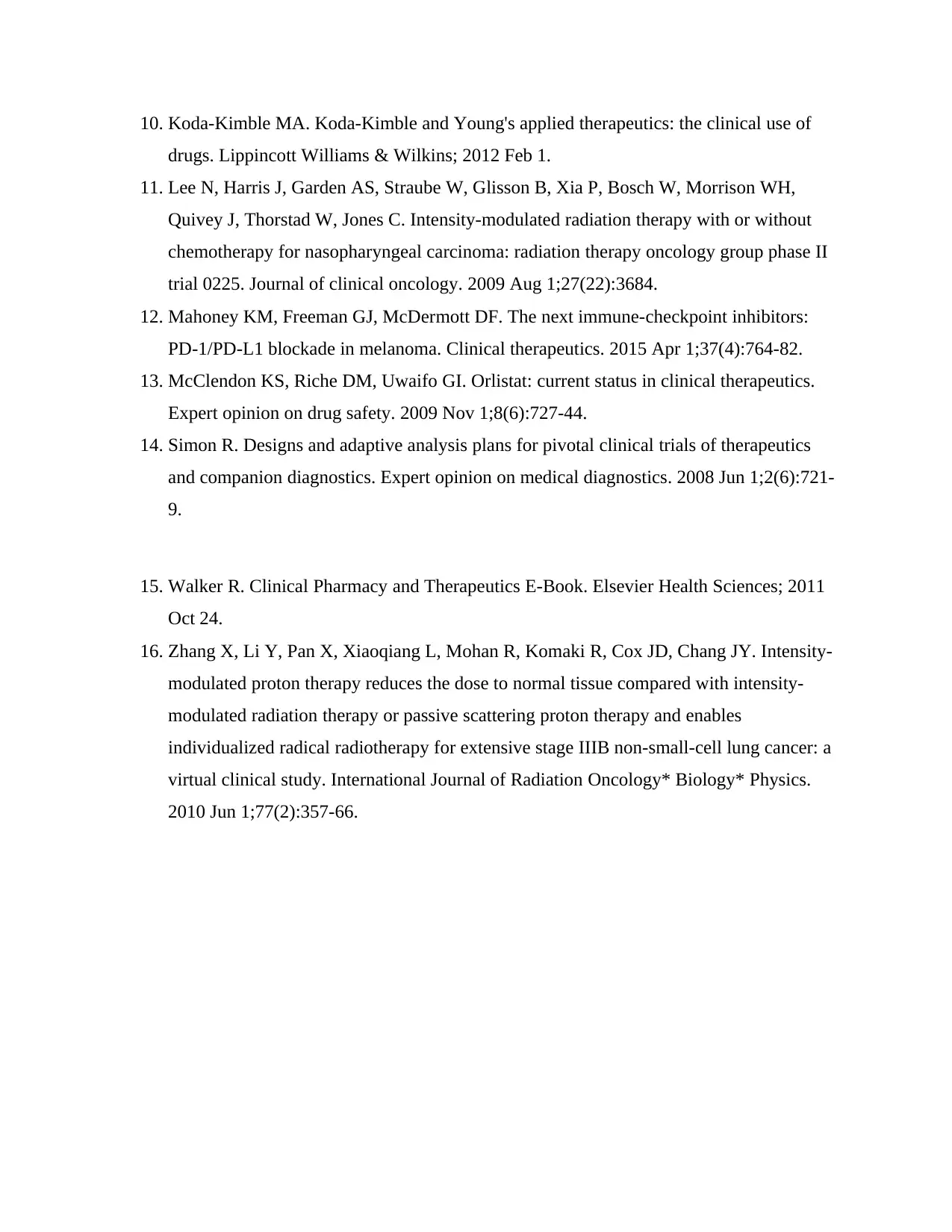
10. Koda-Kimble MA. Koda-Kimble and Young's applied therapeutics: the clinical use of
drugs. Lippincott Williams & Wilkins; 2012 Feb 1.
11. Lee N, Harris J, Garden AS, Straube W, Glisson B, Xia P, Bosch W, Morrison WH,
Quivey J, Thorstad W, Jones C. Intensity-modulated radiation therapy with or without
chemotherapy for nasopharyngeal carcinoma: radiation therapy oncology group phase II
trial 0225. Journal of clinical oncology. 2009 Aug 1;27(22):3684.
12. Mahoney KM, Freeman GJ, McDermott DF. The next immune-checkpoint inhibitors:
PD-1/PD-L1 blockade in melanoma. Clinical therapeutics. 2015 Apr 1;37(4):764-82.
13. McClendon KS, Riche DM, Uwaifo GI. Orlistat: current status in clinical therapeutics.
Expert opinion on drug safety. 2009 Nov 1;8(6):727-44.
14. Simon R. Designs and adaptive analysis plans for pivotal clinical trials of therapeutics
and companion diagnostics. Expert opinion on medical diagnostics. 2008 Jun 1;2(6):721-
9.
15. Walker R. Clinical Pharmacy and Therapeutics E-Book. Elsevier Health Sciences; 2011
Oct 24.
16. Zhang X, Li Y, Pan X, Xiaoqiang L, Mohan R, Komaki R, Cox JD, Chang JY. Intensity-
modulated proton therapy reduces the dose to normal tissue compared with intensity-
modulated radiation therapy or passive scattering proton therapy and enables
individualized radical radiotherapy for extensive stage IIIB non-small-cell lung cancer: a
virtual clinical study. International Journal of Radiation Oncology* Biology* Physics.
2010 Jun 1;77(2):357-66.
drugs. Lippincott Williams & Wilkins; 2012 Feb 1.
11. Lee N, Harris J, Garden AS, Straube W, Glisson B, Xia P, Bosch W, Morrison WH,
Quivey J, Thorstad W, Jones C. Intensity-modulated radiation therapy with or without
chemotherapy for nasopharyngeal carcinoma: radiation therapy oncology group phase II
trial 0225. Journal of clinical oncology. 2009 Aug 1;27(22):3684.
12. Mahoney KM, Freeman GJ, McDermott DF. The next immune-checkpoint inhibitors:
PD-1/PD-L1 blockade in melanoma. Clinical therapeutics. 2015 Apr 1;37(4):764-82.
13. McClendon KS, Riche DM, Uwaifo GI. Orlistat: current status in clinical therapeutics.
Expert opinion on drug safety. 2009 Nov 1;8(6):727-44.
14. Simon R. Designs and adaptive analysis plans for pivotal clinical trials of therapeutics
and companion diagnostics. Expert opinion on medical diagnostics. 2008 Jun 1;2(6):721-
9.
15. Walker R. Clinical Pharmacy and Therapeutics E-Book. Elsevier Health Sciences; 2011
Oct 24.
16. Zhang X, Li Y, Pan X, Xiaoqiang L, Mohan R, Komaki R, Cox JD, Chang JY. Intensity-
modulated proton therapy reduces the dose to normal tissue compared with intensity-
modulated radiation therapy or passive scattering proton therapy and enables
individualized radical radiotherapy for extensive stage IIIB non-small-cell lung cancer: a
virtual clinical study. International Journal of Radiation Oncology* Biology* Physics.
2010 Jun 1;77(2):357-66.
1 out of 8
Related Documents
Your All-in-One AI-Powered Toolkit for Academic Success.
+13062052269
info@desklib.com
Available 24*7 on WhatsApp / Email
![[object Object]](/_next/static/media/star-bottom.7253800d.svg)
Unlock your academic potential
Copyright © 2020–2025 A2Z Services. All Rights Reserved. Developed and managed by ZUCOL.




